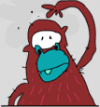MULE: reclaiming the city through pervasive play
The hilarious tongue-in-cheek project is called “Mulecular Urban Ludic Entity” or in short “MULE“. It was developed as a graduation project at Interaction Design Institute Ivrea and “employs interaction design to enable play experiences in urban settings — hinting at the creation of an urban gaming culture”.
MULE is a “cultural platform for generating and making visible alternate perceptions of the city. Using technology-mediated psycho-geographical play experiences, MULE triggers emotional responses in players, enabling novel ways of reclaiming public space-time.”
“To test the possibilities of the platform, a series of pervasive games were designed and prototyped — all of them using geographical elements and physical space.”
“Players find and decode graphical messages hidden in the city, such as camera-phone readable 2D barcodes [the so-called ‘sema-codes’] or invisible UV graffiti. Players then send these hidden messages to the Mule, using their mobile phones. This action enables them to score points and report their location to the system.”
Alejandro Zamudio summarises by saying that MULE “empowers players to assume a ludic-critical stance towards urban life.”
Unfortunately, nothing of this project is as yet online but this post will be updated when other information becomes available.
(This post is the nineth in a series of short features on the graduation projects by the final students of the Interaction Design Institute Ivrea, now located in Milan. As of next week, the Institute will be entirely absorbed within the Domus Academy‘s ‘I-Design” programme.)




